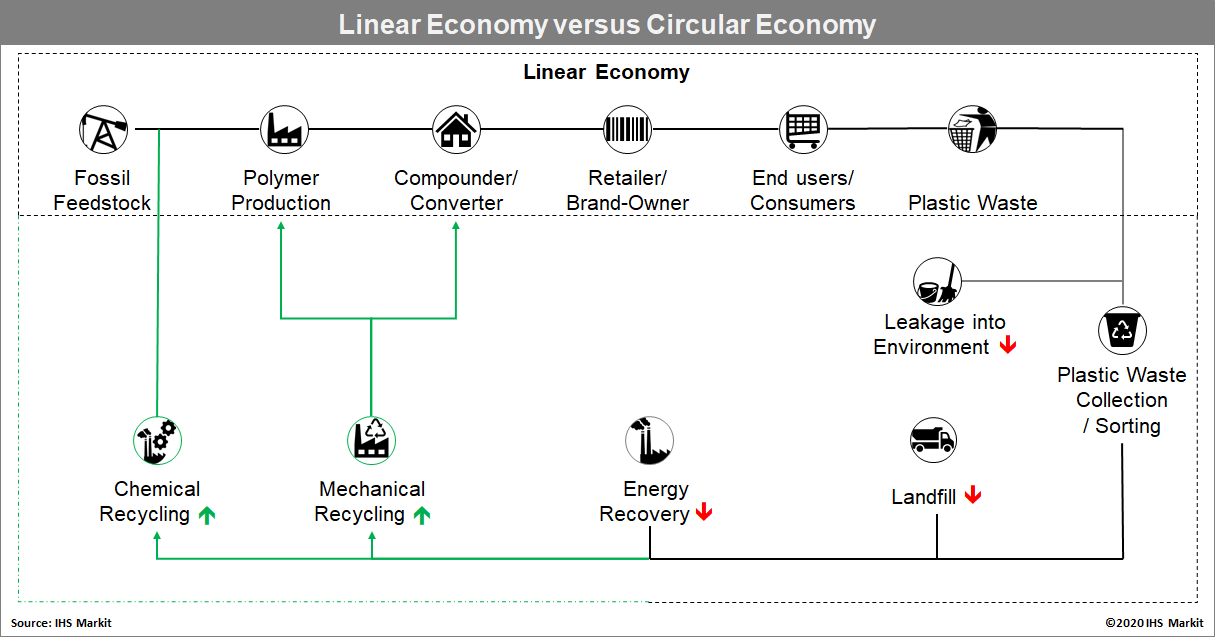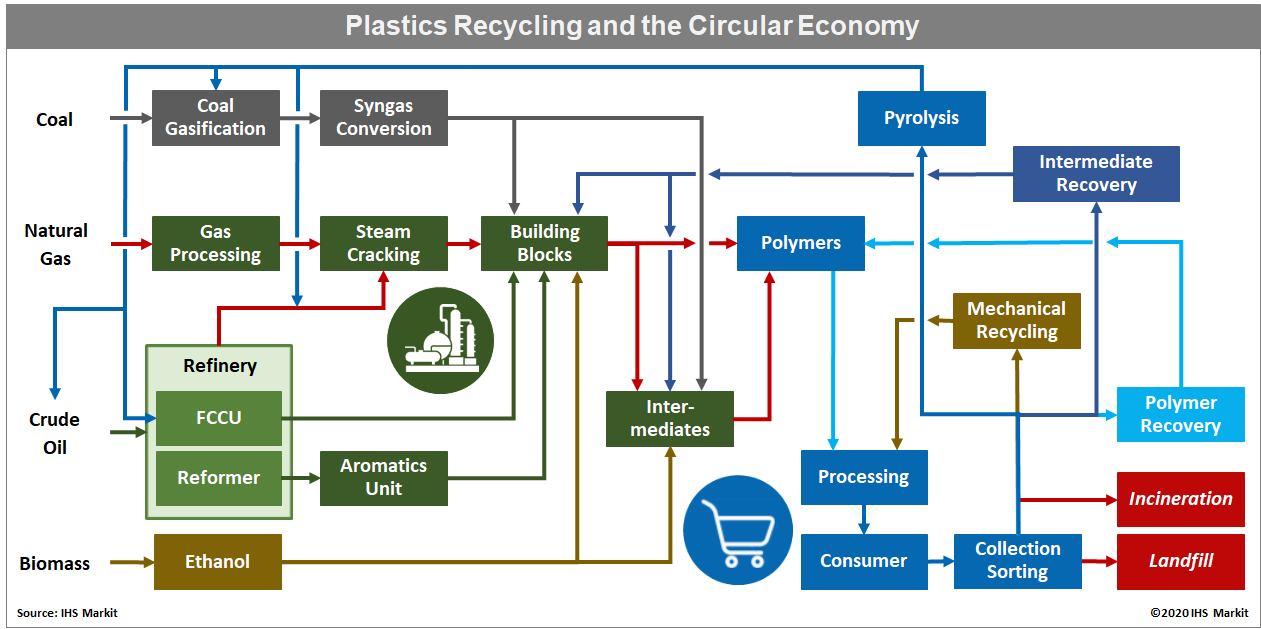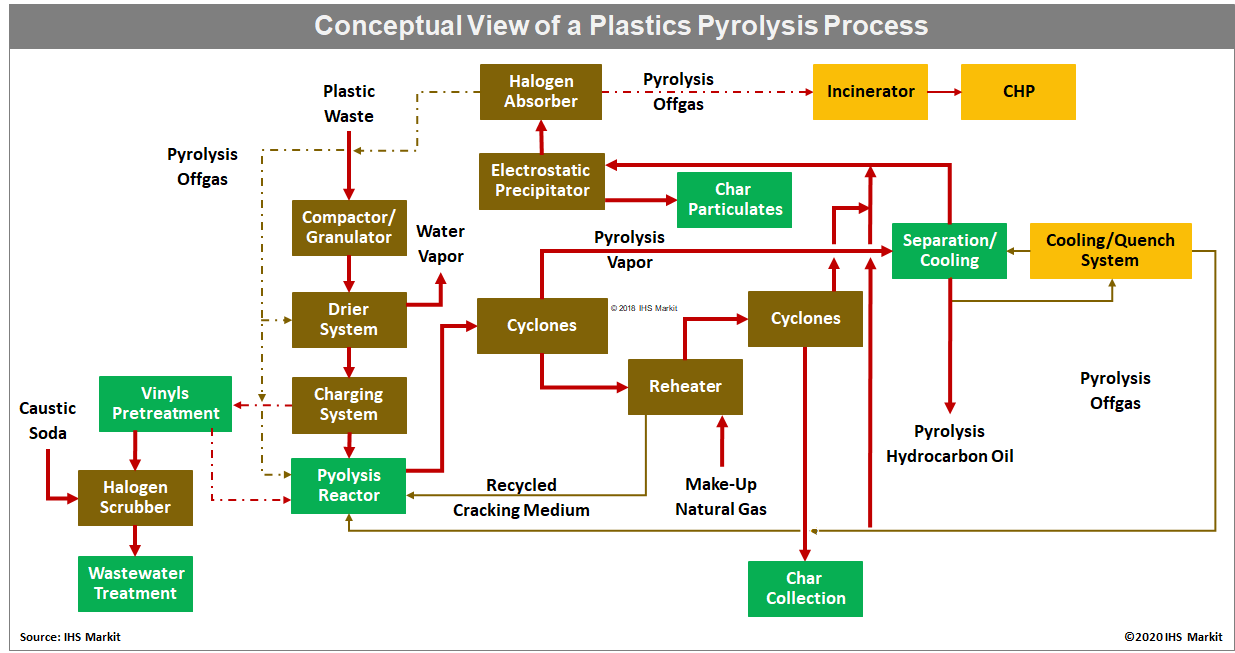Chemical recycling of plastics waste – A new business opportunity in the Arabian Gulf
Over the last three decades, the Arabian Gulf has emerged as a
major global supplier of commodity plastics based on a platform of
advantaged feedstock, world-scale production, and state of the art
technology. In contrast, the region remains a small consumer in
global terms at around 6% of demand. Even so, if Turkey is included
in the Middle East region for analysis purposes, then there is a
regional market of circa 17 million metric tons. This implies a
need for managing waste plastics from manufacturing and the
post-consumer supply chain through mechanical and chemical
recycling, seeking to minimize waste heading for landfill and
incineration.
Chemical or feedstock recycling is being considered as a game
changer that can transform recycling. With chemical recycling,
innovative technologies - such as pyrolysis, gasification, chemical
depolymerization, catalytic cracking and reforming, and
hydrogenation - convert plastic waste into chemicals. These
technologies produce feedstocks such as monomers, oligomers, and
higher hydrocarbons that can in turn be used to make virgin
polymers. In many regions of the world,
especially in European Union, legislation is setting aggressive
targets, driving recycling efforts. The technical limitations in
mechanical recycling to meet those goals, leads to the view that
chemical recycling should play a role in future recycling
strategies. This should be an opportunity for chemical recycling in
the GCC and wider Middle East region for chemical recycling.
In many regions of the world,
especially in European Union, legislation is setting aggressive
targets, driving recycling efforts. The technical limitations in
mechanical recycling to meet those goals, leads to the view that
chemical recycling should play a role in future recycling
strategies. This should be an opportunity for chemical recycling in
the GCC and wider Middle East region for chemical recycling.
It is important to put the role of plastics recycling into the
wider movement for establishing a circular economy and displacing
linear economic thinking. The latter takes hydrocarbon and other
raw materials through various conversion processes to provide
solutions for end-users and consumers, e.g. food packaging, but
directing post-consumer waste to landfill and/or incineration. The
circular economy seeks to recover as much of the waste material and
return it to viable use as a polymer and/or feedstock back in the
petrochemical supply chain.
Recycling approaches
Cost and complexity are challenges to establishing a widespread
chemical recycling infrastructure, compared to mechanical
recycling. Opinions differ regarding carbon lifecycle assessment
(LCA) footprints cost and LCA optimization dependent on how
projects are structured, linking municipal waste collection with
sorting, recycling methods and integration with chemical conversion
operations.
In recent consulting work, IHS Markit has seen common themes emerge
in plastics recycling, especially the circular economy, and how
"circularity" is achieved can vary significantly. Many people will
understand the basics of converting hydrocarbon feedstocks into
petrochemical building blocks that can include olefins and
aromatics or their derivatives, e.g. ethylene glycol. Most polymers
made today are processed with additives, fillers, and fibers to
meet specific end-use customer needs, ranging from barrier films to
keep food fresh to rigid components in automobiles.
Many municipalities collect and sort plastics waste, often
alongside paper, cardboard, and glass. Plastics must be sorted for
subsequent processing. Techniques such as near-infrared systems
that can "see" different plastics help with this. If manufacturers
can be convinced to rethink the design of common household items -
using a single polymer such as HDPE instead of a mix of
polyethylene, ethylene-vinyl acetate (EVA) copolymers, or
polyacetal - recycling could be simplified. This redesign process
is ongoing, especially when it comes to labelling. A simplistic view of the circular
economy and its relation to plastics recycling leads to different
re-entry points, depending on the polymer and recycling solution.
Sadly, today in several parts of the developed world, although
municipalities collect recycling, the plastics are often simply
incinerated.
A simplistic view of the circular
economy and its relation to plastics recycling leads to different
re-entry points, depending on the polymer and recycling solution.
Sadly, today in several parts of the developed world, although
municipalities collect recycling, the plastics are often simply
incinerated.
Once sorted, polymer articles can be cleaned and baled, ready for
downstream use. Many polymers can be mechanically recycled and
re-incorporated into select packaging solutions or made into fibers
for fabrics. In this way the plastics are re-used. As mechanical
recycling continues to grow and develop, one of the many concerns
is the range of applications that can use plastics recycled in this
way as quality and performance can deteriorate.
A key question for mechanical recycling is how many times articles
can be recycled and reprocessed in this way? In order to meet
legislation-mandated recycling targets, mechanical recycling alone
is insufficient.
Chemical recycling can take different forms. Some technologies like
the Vinylloop® process were developed to process PVC in a way that
recovered a polymer for reprocessing. The technology had some
challenges, e.g., entrained plasticizer, but the principle could be
revisited and potentially improved providing polymers for
reprocessing, possibly into pipe, etc. Other technologies applied
to polyesters and polystyrene can in effect "unzip" the polymer
chains to recover monomers and intermediates that can, in turn, be
purified for use in polymer production. The processing of polyolefins and
certain mixed plastic waste can include technologies like pyrolysis
that generates a hydrocarbon oil. Different combinations of
polymers, pyrolysis technologies and post-treatment can yield
feedstocks that can feed a steam cracker, a refinery FFC unit, or
even be treated as some form of "syncrude" for the refinery. In
China, for example, pyrolysis products could be cofed into
gasification units and at present IHS Markit is analyzing in detail
direct polymer gasification/co-gasification with coal.
The processing of polyolefins and
certain mixed plastic waste can include technologies like pyrolysis
that generates a hydrocarbon oil. Different combinations of
polymers, pyrolysis technologies and post-treatment can yield
feedstocks that can feed a steam cracker, a refinery FFC unit, or
even be treated as some form of "syncrude" for the refinery. In
China, for example, pyrolysis products could be cofed into
gasification units and at present IHS Markit is analyzing in detail
direct polymer gasification/co-gasification with coal.
Pyrolysis - a simplified view
A simplified view of the pyrolysis (also referred to as
"thermolysis") process indicates the general principle of the
anaerobic heating of plastic waste, e.g., mixed polyolefins, at
medium temperature at circa 450ºC to 650ºC, with various approaches
to water removal, removal of chlorinated polymers, solids
separation, etc. Designs varies from maximum hydrocarbon liquid
make, which IHS Markit refers to as "pyro-naphtha", through to
maximum gas productions for reforming.
For companies and municipalities in the GCC and the wider Middle
East there are many opportunities to exploit different technology
solutions for recycling plastics. Many processes are developmental
at demonstrations scale. Some processes are already for license,
particularly in the pyrolysis family. These are generally small
scale today in the tens of thousands of metric tons per year range.
Scale economies are challenging, but work is ongoing to improve
scalability.
In addition, technology for the chemical recycling of plastics
continues to evolve. Companies like Synova, for example, are
developing technologies to convert waste plastics into olefins or
aromatics. There is a worldwide effort to develop scalable
processes to meet the plastics waste management challenges of the
future.
The post-consumer supply chain
Although, legislation can place levies on stakeholders, plastics
producers and processors, there needs to be a way in which all
parties in the circular economy chain can thrive, not one party
fairing at the cost of another.
A simple view of the value chain that links the municipality with
plastics production suggests scope for partnerships between private
industry and public bodies. Each has very different business models
and funding approaches. There are therefore opportunities for
public-private partnerships, but the cultures are different. Some
challenging bridges need building, in a way that the "value" is
shared.
If government-established recycling targets are to be achieved, the
links between consumers, municipalities, and petrochemical
production must be improved. After all, public opinion is moved by
media images of a threatened planet and ecosystem. Only through the
collaboration of people, municipalities, and industry - supported
by improved technology along the recycled plastics supply chain -
can we begin to find a cost-effective solution closing the gaps in
the circular economy and reduce polymer-based pollution. Such
opportunities exist in the GCC and wider Middle East region.
